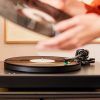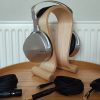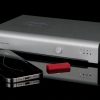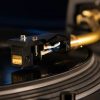Questions:
- Yamaha has receivers that can have two front "presence" speakers in addition to the stereo front left and right speakers and the surround speakers to create even more sense of a live performance. What are your thoughts on this approach?
- Yamaha has DSP, which can "process" sounds. Dolby Pro Logic II and dts Neo6 have their methods, but isn't it much better to take the ambient (out of phase) reflections recorded by the sound engineer on the CD recording and simply decode that info and not process it?
Answer: (by Alan Lofft from Axiom Audio)
Thanks for your comments. First, a minor correction: when Yamaha uses "DSP" in the context of ambiance and hall synthesis, they mean "Digital Sound Field Processing," not Digital Signal Processing, which is the usual definition of DSP. (Of course, Yamaha uses lots of digital signal processing in order to recreate many of their hall ambiance modes.)
Dolby's early development of analog Dolby Surround was intended for playback of movie soundtracks in cinemas. It was a simple matrix system that encoded and derived a center-channel signal and single mono surround channel (over two speakers) piggy-backed onto a standard left/right stereo signal. It was primitive but it worked, and its later evolution to Pro Logic in 1989 added relatively sophisticated "steering logic" to greatly increase the separation between left, center, right and surround channels. However, it was still intended largely for movie soundtrack playback, not for music.

Introduced in 2000, Dolby Pro Logic II was intended not only to derive five channels from a Dolby Surround encoded stereo movie soundtrack but also to "bring out the hidden spatial cues in conventional stereo music recordings in a natural and convincing way. The listener is drawn into a 3-dimensional space rather than hearing a flat, 2-dimensional presentation. This not only develops a more involving sound field, but also solves the narrow "sweet spot" problem of conventional stereo reproduction." These are the words of Roger Dressler, one of Dolby's key development engineers of Dolby Pro Logic II. The later "x" version of DPL II derives 6.1 or 7.1 channels from a stereo source.

Both Dolby Pro Logic II, dts Neo 6 and Harman/Kardon's Logic 7 in fact do analyze the relative phase and level between the input signals and use the ambient out-of-phase information to achieve their surround effects. Although the operation is quite complex, the digital algorithms route the out of phase information to the surround channels and lock the in-phase information into the center (vocalists and instruments that are mixed with equal signals in the left and right channels), leaving left- and right-biased information to the main left and right front speakers untouched. Note too that DPLII, dts Neo 6 and Harman/Kardon's Logic 7 all have Cinema and Music modes.
The Yamaha "presence" speakers do involve Yamaha's proprietary soundfield processing. In the old days of analog Pro Logic, which wasn't convincing with stereo music signals, the "presence" speakers could add a pleasant dimension to stereo recordings and soundtracks, providing greater spaciousness and dimensionality. However, with the development of sophisticated Dolby Digital Pro Logic II(x), the benefit of the presence speakers is greatly diminished. Back in the old days, I had a Yamaha processor with presence speakers installed. Properly set up Dolby Digital Pro Logic II (or dts Neo 6 or H/K Logic7) in a 5.1 or 7.1 setup is so effective now that there is no need for "presence" speakers. In my judgment, they are artifacts of another era, no longer required.
Dolby Labs offer considerable freedom to licensees in how they implement Pro Logic II (x) on various AV receivers. DPLII allows for adjustable modes for "Panorama," "Dimension," and "Center Width". These may or may not be implemented in a particular brand or model of AV receiver, depending on the choice of the designers and the target price.






























